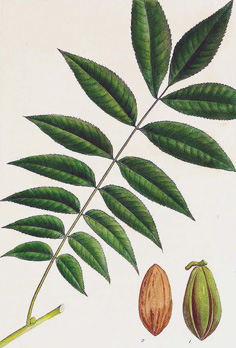Peckish for Pecans
By Audrey Stallsmith

When I was a child and the snow fell, my mother always rushed to the kitchen and made snow ice cream and divinity fudge—egg whites, sugar, and pecans, mostly. It was a lark then and I always associate divinity fudge with snowstorms.
Eudora Welty
At the Christmas season pecans appear in much more than fudge. They also flavor fruitcakes, the tassies (miniature tarts) about which a friend was bragging at church the other night, and, of course, pecan pie. Rumor holds that it was the wife of a Karo bigwig who invented that. If so, she probably was worth her weight in gold to him.
Fortunately, during the holiday season, most of us put off worrying about calories until the New Year. And we could make a case that pecans are very good for us, being high in monosaturated fats and antioxidants as well as some of the B vitamins and trace minerals. They also are the quintessentially American nut, being native to the south central U. S. and Mexico and grown by both Washington and Jefferson.
Fur traders who brought pecans (Carya illinoinensis) back from the nation’s interior called them Illinois nuts, explaining their species name, but it seems likely that they originated farther south than that. They tend to produce best where summer temperatures are hot, even though they can survive as far north as New York. Carya derives from the Greek karyon (“nut”).
Related to the hickory nut, the pecan also grows inside a husk and its shell originally had to be broken open with a rock. That basically is the meaning of the Algonquin pacane, from which we derive pecan. Years of improved cultivars, however, have made pecans thin-shelled enough to be cracked by strong hands and increased the size of their “meats.” Not always a good thing, since the weather can crack them more easily too.
Around 1846, a slave named Antoine at the Oak Alley Plantation in Louisiana apparently originated the grafting techniques that still are used today. The cultivar he created later would be named ‘Centennial” after it won the plantation’s then owner an award at the Centennial Exhibition in 1876. Many later cultivars have been named for the Native American tribes who first learned to make use of the wild nuts.
We never ate pecans much when I was growing up, since walnuts were cheaper. But we usually did get a sack of mixed whole nuts at Christmas which would include a few. I occasionally would splurge on them when making German Chocolate Cake too.
They do seem to lack the tinge of bitterness that walnuts sometimes have. And they bring back pleasant members of long-ago holiday sweets and sweetness.
The Carya illinoinensis image is by H. J. Redoute from The North American Sylva by F. A. Michaux, courtesy of plantillustrations.org.








